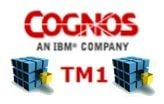IBM Cognos TM1 version 10 has now been around for a good while and has already gone through several...
Seven Ways IBM Cognos TM1 Aids Forecasting
Summary
Does your company suffer from common forecasting problems? In a white paper on the subject, the IBM Beyond Budgeting Round Table illustrates how the IBM Cognos TM1 business intelligence solution can help finance managers identify common symptoms and implement solutions that lead to a healthier organization.
7 Ways IBM Cognos Aids Forecasting
Whether companies realize it or not, they likely suffer from at least one symptom of forecasting illness. Misconceptions and antiquated forecasting processes lead to decreased accuracy, quality and profitability for businesses. To successfully treat these forecasting illnesses, finance managers must identify common symptoms and implement solutions that lead to a healthier organization.
In a white paper titled “Seven Symptoms of Forecasting Illness” the IBM Beyond Budgeting Round Table illustrates how the IBM Cognos TM1 business intelligence solution can help identify and cure these pervasive ailments.
1) Semantic confusion: A company might show signs of semantic confusion if the organization finds it difficult to deal with unexpected or undesirable forecasts. This symptom can manifest as a blurred line between the forecast and the company’s goal.
Cure: To address this symptom, companies can use the IBM Cognos TM1 business intelligence solution to allow managers to create, maintain, and reference multiple forecast scenarios easily and efficiently.
2) Visual impairment: A company may suffer from visual impairment if it is obsessed with the year-end forecast numbers, or if it is surprised by new developments at the beginning of the fiscal year.
Cure: Companies should focus on building a comprehensive company forecast strategy. BP is a great example of the power of combined forecasting. BP brought all of the company’s stakeholders together in a large auditorium and efficiently completed a comprehensive company forecast.
In some companies, salespeople are either pushing their numbers to count toward next year’s sales goals or holding their numbers to this year to benefit themselves under their compensation plans. You really need to separate compensation from the forecasting process to take this manipulation out of the process and get truer information.
3) Systemic overload: Systemic overload is characterized by an increasing need to add greater detail and additional analysis in the misguided view that more data is always better in the forecasting process.
Cure: Don’t get stuck in the fine details. With IBM’s TM1 financial planning solution, companies can quickly build scenarios that reflect potential realities while achieving a balance between initial data input and subsequent analysis.
For best practices, you should only be planning the primary financial line items in your business. You should identify 20-50 of these line items that are most important in your business. If you go into too much detail in your budget, you are going to spend all your time configuring the budget and not enough time doing the analysis of it afterward.
4) Prosperity syndrome: If a company’s forecast reflects optimistic growth regardless of negative industry trends or current economic conditions, it may be suffering from prosperity syndrome.
Cure: To alleviate this symptom, companies should consider current market conditions, examine expected competitor strategies and rely on accurate data provided by TM1 financial systems.
5) Lack of coordination: If an organization has multiple sources, or silos, of data, it can’t create reliable, consistent forecasts.
Cure: In order to have a good forecasting process, you also need good data organization in the company. This can be achieved by adopting a single forecasting system throughout the entire organization and feeding data into the forecasting system from other enterprise systems like the General Ledger or the Human Resource Management systems.
6) Asocial behavior: If an organization routinely manipulates or alters its forecasts, even if doing so is not in the best interest of the company, it may suffer from asocial behavior.
Cure: Companies should reward managers and employees based on the value they provide, rather than rewarding “sandbaggers” for abusing the system. This can be achieved by eliminating links between incentive compensation and forecasts.
7) Lack of executive sponsorship: If individual departments are attempting to improve the forecasting process, but others are split over the importance of the task, an organization may suffer from a lack of executive sponsorship.
Cure: In order for a company to be successful in their financial planning and reporting efforts, it has to come from the top down. These processes will touch multiple parts of the organization and must be designated a key strategic initiative of the entire company in order for it to be successful.
All companies suffer from at least one type of forecasting illness. These factors are a reminder that every business needs to constantly examine its core process and culture to ensure they’re using the most accurate forecasting process and tools. By implementing a data analysis tool like the IBM Cognos TM1 business intelligence solution, organizations can achieve a high level of efficiency and promote healthier forecasting.


